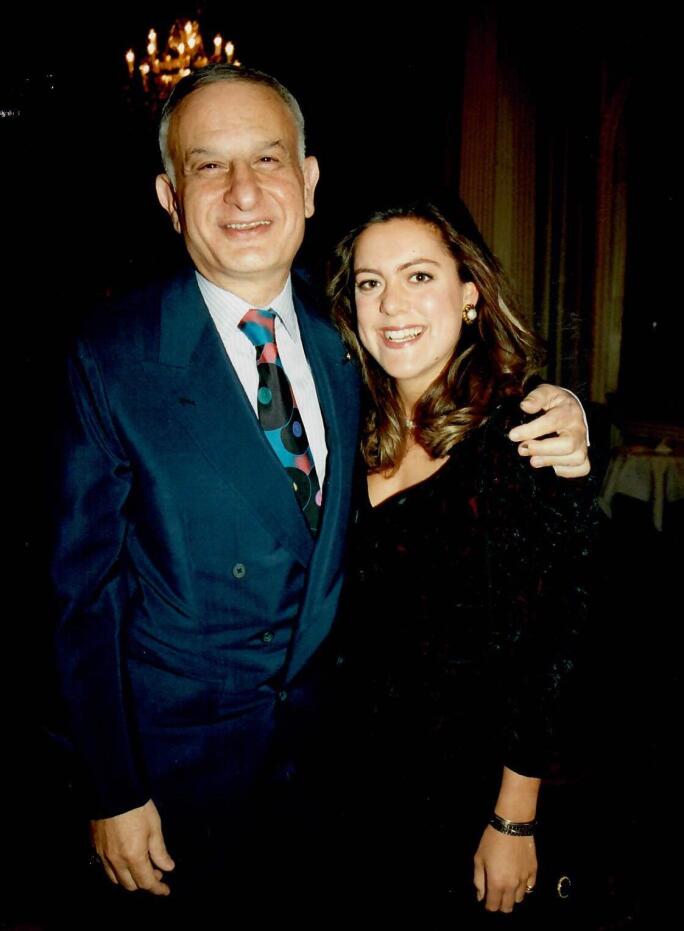
The late publisher, entrepreneur, bon viveur and collector Naim Attallah, CBE dominated the London social scene in the 1980s and 1990s as the flamboyant boss of Quartet Books. But as the art, accessories, furnishings and personal effects in A Gentleman’s Cabinet of Curiosities – The Collection of the late Naim Attallah, CBE proves, beyond the exuberant personality, was a discerning and refined connoisseur.
Former employee and close friend, author Anna Pasternak, recalls her time working with the man so affectionately known to his many friends, simply as ‘Tiger’.
We were dining on langoustines, with vintage pink champagne, at his Dordogne home. The conversation was animated, gossipy and fun. He was attentive, charismatic and intense. Yet this was not an admirer. This was my boss and we were on a “working” holiday, which merely meant that we sent a few faxes after sunbathing and shopping for antiques. This was in May 1988, I was twenty one years old and couldn’t believe the excitement of being on a work trip, where I had travelled Business Class for the first time in my life.
This was the unparalleled and exotic world of Palestinian entrepreneur Naim Attallah, who ran the most talked-about publishing company of mid-80s London, Quartet Books. Back then, literary London was abuzz with tales of Attallah and his “harem,” – mainly aristocratic girls and the scions of literary legends whom he employed. Attallah was an immensely talented and colourful man and possessed of a wild imagination, that seemed to make anything that he wanted to happen, happen.
Naim published books that no other publisher would have risked their money or reputation on. He underwrote literary magazines that haemorrhaged cash. He was also a brilliant businessman, who helped transform the fortunes of Asprey, over the course of a long and fruitful association, including a five-year spell as chief executive.
I became one of the Quartet Girls, through my grandmother, Josephine Pasternak. I was job-hunting, fresh out of Oxford, when she suggested that I ring Attallah, who had interviewed her for his best-selling collection of interviews, Women, and had published the memoirs of her painter father, Leonid Pasternak. I went to his Soho headquarters which, to a strait-laced ingénue like me, were terrifying and mesmerising.
Attallah sat resplendent in the penthouse, a huge tiger skin on the wall. He sported his trademark odd-coloured socks while his suit flashed vivid pink silk linings. He wore three watches, two up one wrist and one on another and on his fingers, rubies and emeralds sparkled. Dewy, mini-skirted beauties attended to his every whim, while he affectionately teased them, blowing kisses. He would break off mid-sentence to have one of his leggy minions call the cook to enquire if his mid-morning mango was juicy enough.
He offered me a job in the publicity department of Quartet (my surname was qualification enough). Everyone knew that Naim had the best literary connections and that working for him was like attending the weirdest, yet most wonderful finishing school. Each day one of us was chosen to eat lunch with him. In the basement of his empire, a lavish lunch was laid out in the dining room with silver candelabras, linen napkins, crystal glasses and four-course place settings. Drops of rose water were ritualistically added to his coffee afterwards, by the stiletto-wearing young Sloane Ranger cook.
No one had a contract at Quartet. We were paid a pittance to turn up to parties in mandatory mini skirts. The only actual work I recall was lugging sacks of books to the post office to send out for review.
Perusing the lots of this sale – rich and vivid in content, like Attallah himself – instantly transported me back to those glory days. There are the two drawings by my great-grandfather, Leonid Pasternak, from his Palestine series. The minute Naim saw them, they reminded him of his homeland. When he was told that my grandmother would never sell them, he replied “She’ll sell to me.” And she did.
This Gentleman’s Cabinet of Curiosities perfectly sums up Attallah’s eclecticism and interest in the world. His love of religious iconography – there are beautiful Russian icons, such as a silver-gilt and cloisonné enamel icon of St Nicholas the Wonderworker, from Moscow (1899-1908) is juxtaposed against his paintings of nudes- which I remember, hanging in his office. Particularly striking is Paul Sieffert’s Reclining Nude.
There are traditional English antiques – his Regency Canterbury, circa 1820, which was in his Mayfair flat, stuffed with magazines- and his Ghanaian Ashanti stool. Attallah liked to read every single Sunday newspaper. He would spread out a white sheet, to protect his silk rugs from newsprint, then display the myriad supplements and sections across the floor. He would perch on his stool as he leaned forwards, flicking through them all. He was incredibly well-read and well-informed, which makes this collection such a touching representation of his character. The superb William Huggin’s painting, The Tiger’s Lair, (1861), sums up for me, the essence of our Quartet days. His Soho offices were known as his lair, and he became affectionately known as Tiger, after the wild animals he adored.
I shall be bidding for the small patinated bronze paperweight in the form of a tiger by Tiffany studios, New York. A perfect memento for my desk, of Naim, of his literary legacy and of the ferocious loyalty that we all felt for him. As well as being a friend and mentor, he created the most fun, memorable environment that any employer could. He catapulted me into my writing career, and for that alone, I shall always be grateful.
A Gentleman’s Cabinet of Curiosities – The Collection of the late Naim Attallah, CBE is open for bidding until November 23rd, 2021 at 15:00 GMT, London
